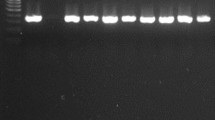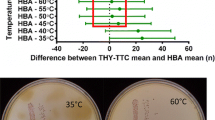Abstract
The new Vitek 2 GN card (bioMérieux, Marcy-l'Etoile, France) was developed for better identification of fermenting and nonfermenting bacilli. This new card allows the identification of 159 taxa. A total of 426 isolates (331 fermenting and 95 nonfermenting gram-negative bacilli) belonging to 70 taxa covered by the database were evaluated. All isolates were identified in parallel with the ID 32 GN, the API 20E, and the API 20NE methods. The system correctly identified 97.4% (n=415) of the strains. Only 2.1% (n=9) needed additional testing. One strain (0.25%) was misidentified (Klebsiella pneumoniae subsp. pneumoniae), and another one (0.25%) was not identified (Morganella morganii subsp. morganii). The new GN card gives more accurate identifications overall for gram-negative bacilli when compared to the systems described in other similar studies.
Similar content being viewed by others
Avoid common mistakes on your manuscript.
Introduction
The fully automated Vitek 2 system (bioMérieux, Marcy-l'Etoile, France) has evolved to improve the performance of identification products and to increase the breadth of the databases. Different evaluations of this identification system have been published previously [1–7]. One of these studies [7] reported recently on the performance of the new Vitek 2 Advanced Colorimetry GN card (GN card). The GN card contains 47 colorimetric tests compared to 41 fluorometric tests in the previous ID-GNB card. The GN database includes 159 taxa, whereas the ID-GNB is limited to 101 taxa. In this study, we evaluated the performance of the GN card for identification of the most clinically relevant fermenting and nonfermenting gram-negative rods.
Materials and methods
Vitek 2 system
The GN card was used according to the instructions of the manufacturer (bioMérieux, Marcy-l'Etoile, France). The card contains 47 colorimetric tests that measure utilization of carbon sources, enzymatic activities, and resistance to inhibitory substances. The GN card allows identification of 159 gram-negative taxa. Test reactions are read automatically every 15 min until a maximum incubation time of 10 h. A specific kinetic algorithm calculation allows for a final identification result after 2–10 h of incubation. The GN card employs the use of some novel colorimetric substrates, and the Vitek 2 instrument has been modified with a new optical system.
Strains
A total of 426 unique clinical isolates (95 non-fermenting and 331 fermenting gram-negative bacilli) representing 70 taxa were tested (Table 1). Two hundred forty isolates came from the medical microbiology laboratories (fresh isolates) and 186 from our stock collection. Stock isolates were stored in lyophilized form. Forty-one of the fresh isolates were tested directly from the primary isolation culture on Columbia sheep blood agar. The age of the others was not higher than 1 month, and none had ever been frozen or lyophilized. All other isolates were subcultured on Columbia agar with 5% sheep blood, MacConkey agar, or trypticase soy agar (bioMérieux) prior to testing to ensure purity and viability. The isolates were identified by using at least two different identification kits, including API 20E and/or API 20NE and/or ID 32 GN (bioMérieux), which served as the reference method. Discrepancies were resolved by using additional API galleries (Biotype 100, API 50 CHE, bioMérieux) or by sequencing of the 16S ribosomal RNA gene.
Reporting of results
Identifications obtained with the new GN card were compared with the results of the reference method and summarized in four categories: (i) one choice, which corresponded to unambiguous correct identification at the species level, (ii) low-level discrimination between several species, including the correct species (low discrimination), where simple additional tests can be used to resolve the identification, (iii) misidentification (mistaken ID), when the species identified with the GN card was/were different from that/those identified by the reference method, and (iv) no identification (no ID), when the GN card was not able to give an identification result. The three strains tested that belonged to species not included in the database were excluded from the summary reports.
Results
The identification results obtained with the Vitek 2 GN system are presented in Table 1. The taxonomy evolutions applied to the GN card are reported in Table 2. Of the 426 strains belonging to the 70 taxa studied, 415 (97.4%) were correctly identified (1 choice), and nine (2.1%) required additional tests (low discrimination). Only one strain (0.25%) was not identified, and another strain (0.25%) was misidentified. The fermenting gram-negative bacilli were better identified (98.5% correct) than the nonfermenting gram-negative bacilli (93.7% correct).
The nine isolates for which low discrimination results were obtained (Table 3) were three fermentative bacilli, (Citrobacter freundii, Klebsiella oxytoca, and Moraxella osloensis) and six non-fermentative bacilli (Acinetobacter lwoffii, Achromobacter xylosoxidans subsp. denitrificans, A. xylosoxidans subsp. xylosoxidans, Comamonas testosteroni and 2 Pseudomonas fluorescens). To allow the differentiation of the discrepancies, supplemental tests such as nitrate reduction, production of indole, fermentation of carbohydrates such as d-melibiose or d-glucose, pigment production, gelatin hydrolysis, oxidase, and assimilation tests were used (see Table 3).
Only one isolate (Morganella morganii subsp. morganii) remained unidentified by the system. In addition, one strain of Enterobacter amnigenus was misidentified as Enterobacter cloacae by the system.
All isolates tested directly from the primary isolation medium were identified correctly except for one unidentified strain (Morganella morganii subsp. morganii). No difference in identification results was observed between fresh isolates and stock collection strains.
Table 4 lists for each species the average time required for a final identification. The mean time to identification of fermentative strains was 4.3 h and to identification of non-fermentative strains 6.1 h.
Discussion
Several investigators have described the usefulness of the previous Vitek 2 ID-GNB card for identification of gram-negative rods [1–7]. In our study, conducted with 426 clinical gram-negative bacilli, we showed correct identification for 97.4% of the strains without supplemental tests and for 99.5% after performing very simple additional tests (NO3, pyocyanin, gelatin, indole, fermentation of sugars, and oxidase). Compared to the ID-GNB card, the GN card performed better. Table 5 details the performance of the ID-GNB card and the new GN card. Fermenting and nonfermenting strains are differentiated. In addition, the ID-GNB card identifies most of the relatively inert nonfermenting gram-negative bacilli as a large heterogeneous group (“various nonfermenting gram-negative bacilli”, VNFGNB) that includes clinically important taxa such as Acinetobacter lwoffii, Moraxella spp., Pseudomonas fluorescens, Pseudomonas putida, and Pseudomonas stutzeri. The VNFGNB “taxon” has been suppressed from the GN card, and the different species belonging to this group have been included in the new database, allowing accurate and discriminate identification of non-fermentative gram-negative bacilli.
Overall, the identification of non-fermenting strains has been substantially improved (from 62.7% [2] to 92.4% [4] correctly identified in previous published reports to up to 93.7% in the present study); moreover, identification of fermenting strains improved as well (from 83.4% [1] to 97.2% correctly identified [2] to up to 98.5%).
The results of our study and those of Funke et al. [7] were very similar: one-choice identification for 92.4% (non-fermenting) and 98.6% (fermenting) in the Funke et al. study, and 93.7% (non-fermenting) and 98.5% (fermenting) in our study. The new GN card system identified 99.5% [97.4% (1 choice)+2.1% (simple additional tests)] of the 426 strains evaluated.
The misidentification and non-identification rates have also been dramatically reduced with the GN card: only one of the 426 strains in our study and four of the 655 strains in the study of Funke et al. [7] were misidentified or not identified.
Testing the strains directly from primary isolation plates did not appear to impact the performance of the GN card, since the collection strains and the fresh isolates were identified with the same level of accuracy. Moreover, testing performed from chromogenic media did not interfere with the automatic reading because of the low level of the inoculum (0.5 McFarland standard).
Furthermore, the time-to-call results provided 80% of the identifications between 3 h and 6.5 h in our study (Table 4). We consider that the new Vitek 2 Advanced Colorimetry GN card may be a very high-performing tool for the identification of gram-negative bacilli. In addition to our study and that of Funke et al. [7], which together included 83 species frequently encountered in a clinical setting, it would be of interest to carry out additional studies to test other taxa in the Vitek 2 GN database that are less frequently encountered in routine clinical microbiology laboratories and have not been covered by our study.
References
Funke G, Monnet D, DeBernardis C, von Graevenitz A, Freney J (1998) Evaluation of the Vitek 2 system for rapid identification of medically relevant gram-negative rods. J Clin Microbiol 26:1948–1952
Jossart MF, Courcol RJ (1999) Evaluation of an automated system for identification of Enterobacteriaceae and nonfermenting bacilli. Eur J Clin Microbiol Infect Dis 18:902–907
Joyanes P, del Carmen Conejo M, Martinez-Martinez L, Perea E (2001) Evaluation of the VITEK 2 system for the identification and susceptibility testing of three species of nonfermenting gram-negative rods frequently isolated from clinical samples. J Clin Microbiol 39:3247–3253
Ling TKW, Tam PC, Liu ZK, Chieng AFB (2001) Evaluation of Vitek 2 rapid identification and susceptibility testing system against gram-negative clinical isolates. J Clin Microbiol 39:2964–2966
Gavin PJ, Warren JR, Obias AA, Collins SM, Peterson LR (2002) Evaluation of the Vitek-2 system for rapid identification of clinical isolates of gram-negative bacilli and members of the family Streptococcaceae. Eur J Clin Microbiol Infect Dis 21:869–874
O’Hara CM, Miller JM (2003) Evaluation of the Vitek 2 ID-GNB assay for identification of members of the family Enterobacteriaceae and other nonenteric gram-negative bacilli and comparison with the Vitek GNI+ Card. J Clin Microbiol 41:2096–3101
Funke G, Funke-Kissling P (2004) Evaluation of the new VITEK 2 card for identification of clinically relevant gram-negative rods. J Clin Microbiol 42:4067–4071
Acknowledgements
We thank Sandrine Pétré, Bernadette Blanc, Béatrice Celliere, Geneviève Bossy, Daniel Monget, and Dave Pincus for their useful discussions about this study.
Author information
Authors and Affiliations
Corresponding author
Additional information
This study was presented in part at the 104th General Meeting of the American Society for Microbiology, New Orleans, Louisiana, 2004, Abstract C-180.
Rights and permissions
About this article
Cite this article
Renaud, F.N.R., Bergeron, E., Tigaud, S. et al. Evaluation of the new Vitek 2 GN card for the identification of gram-negative bacilli frequently encountered in clinical laboratories. Eur J Clin Microbiol Infect Dis 24, 671–676 (2005). https://doi.org/10.1007/s10096-005-0026-6
Published:
Issue Date:
DOI: https://doi.org/10.1007/s10096-005-0026-6




